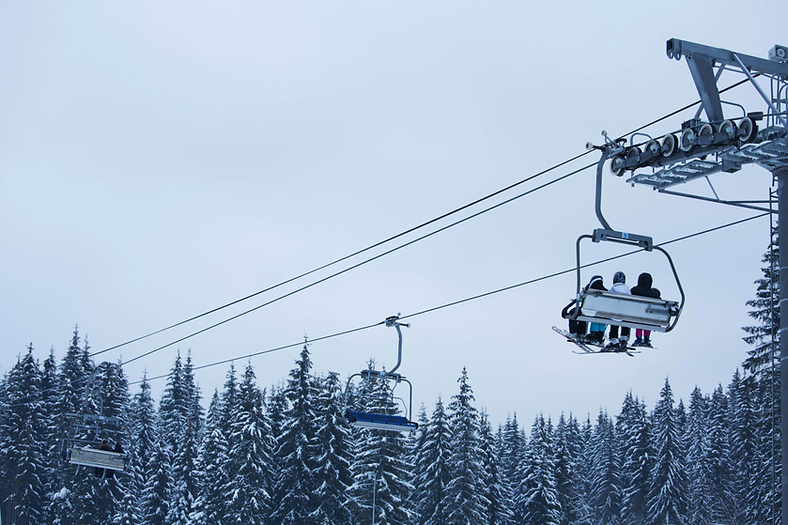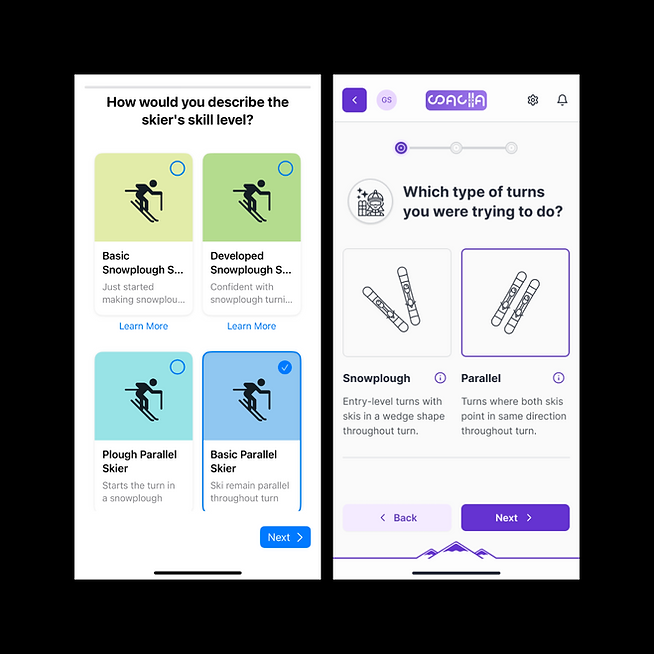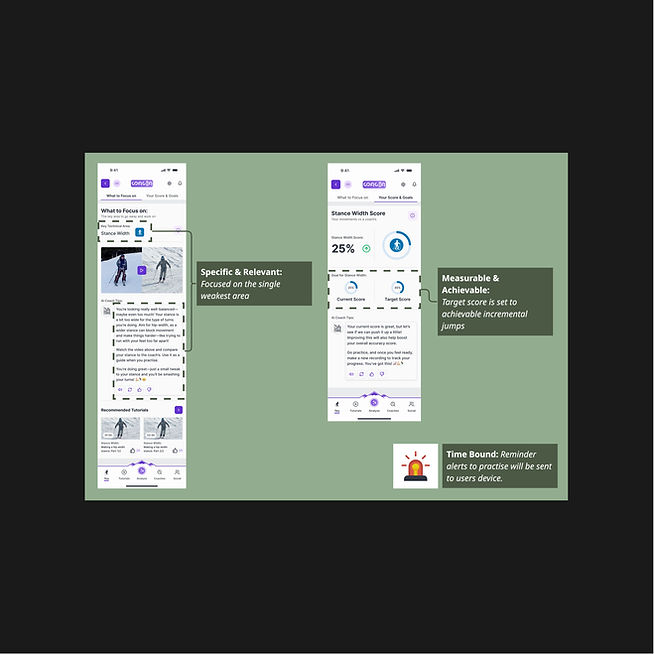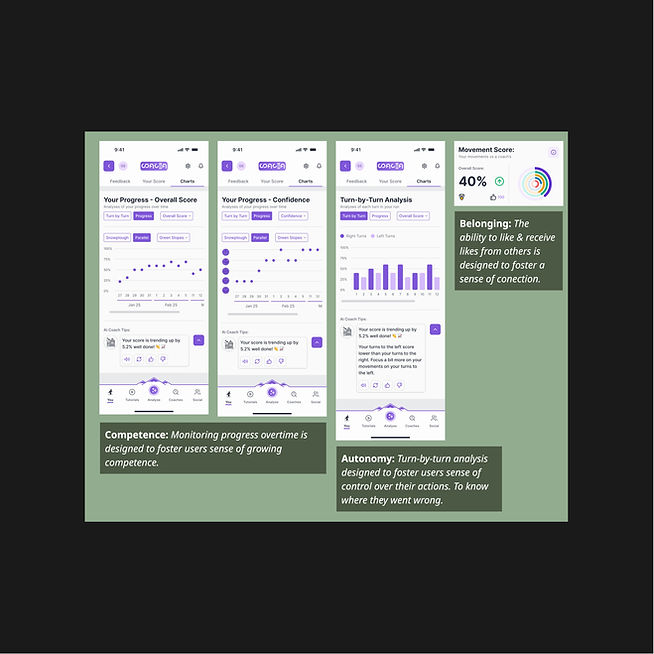COACHA APP
I was approached by an industry-leading ski school, which operates across France and Switzerland to lead the design of the Coacha app. This is an ongoing role, and so far I’ve been heading up the research and design phases of the project.
Coacha is a ski coaching app that uses AI body-tracking technology to analyse user-submitted skiing videos and deliver personalised feedback.
Designed for beginner to intermediate skiers, it supports skill development outside formal lessons and during short ski holidays. The app also enables learners to connect with real-life instructors directly through the platform, making it easier to book lessons, receive guidance, and for instructors or ski schools to promote and sell their services.


A mini Overview
My role
My activities, actions and outcomes so far have included:
Research Phase:
-
Ran workshops with professional ski instructors to define user needs, identify learning progressions (based on BASI Central Theme), and co-create performance metrics.
-
Conducted surveys and in-depth interviews with learner skiers to understand pain points, motivations, behaviours, and digital habits.
-
Created empathy maps, journey maps, and personas based on insights from both learners and instructors.
-
Benchmarked similar apps to identify UX opportunities and content strategies.
Design Phase:
-
Created user stories and mapped core user journeys across four project phases.
-
Designed and iterated low- to high-fidelity wireframes and interactive prototypes in Figma.
-
Defined a visual design system including colour palettes tested for accessibility and use in outdoor conditions.
-
Collaborated with development team to establish technical feasibility for concepts within design
-
Conducted usability testing in both snowdomes and real ski resort environments.
-
Refined the feedback flow, instructional content, and interface tone based on iterative user feedback.
-
Designed features for both learner and instructor user types, including performance tracking, contextual feedback, and in-app communication.

Problem Statement
Who is affected by the problem?
Beginner and intermediate skiers who lack access to tailored guidance to improve their skills outside of regular ski lessons.
What is the problem?
Skiers struggle to progress due to lack of personalised feedback, inconsistent advice, and infrequent practice, leading to slow improvement, frustration, and skill regression.
Where & When does this problem occur?
The problem occurs during ski trips, where private coaching is expensive, personalised guidance is limited, and users lack tailored support between lessons, leading to skill loss due to long gaps between trips.
Why does it exist, and why does it matter?
High costs of lessons make private lessons harder to access, & Cheaper group lessons can lack personalised guidance.
Skiers can lose track of their development plan in-between lessons & have poor technical understanding to self analyse.
Advanced skiing friends often struggle to assess learners accurately and suggest improvements.
Limited feedback hinders skill progression, leading to slow improvement, reduced confidence, and frustration.
Selecting the Target Users
The target users were selected based on market research from ski schools, which highlighted that beginner to intermediate lessons are the most in-demand and that ski schools are often oversubscribed.
To identify the specific skill levels of these users, I referred to the British Association of Snowsports Instructors (BASI) Central Theme—a progression framework that guides skiers from complete beginner to basic parallel level. I focused on four distinct stages within the Central Theme to define the learner skier user base for the product.
The secondary user base includes ski instructors and ski schools. Research for these groups is ongoing.
research workshop
One of the core challenges in designing Coacha was determining the right movement metrics to form the foundation of the app’s AI feedback system. These metrics needed to deliver clear, actionable insights to learner skiers while also enabling real-life instructors to monitor progress remotely and use this data to upsell tailored lesson services.
To solve this, I collaborated with industry-leading ski instructors and instructor trainers in a series of research workshops. Together, we brainstormed the most common faults seen in beginner to intermediate skiers—the app’s primary user base. We then affinity mapped these faults to uncover patterns and themes, which helped us identify four key technical movement metrics that the AI could reliably assess.
Each metric was linked to specific joint positions, enabling body tracking analysis to measure the user’s performance against a templated demo score recorded by an expert instructor. This data-driven feedback loop not only supports independent learning but also provides a measurable way for instructors to engage with learners between lessons.


USABILITY TESTING
To test early concepts of the Coacha app, I designed a low-fidelity prototype and carried out usability testing with beginner and intermediate skiers in real-world environments—including ski resorts in France and Switzerland, as well as UK snowdomes. One key insight from these sessions was that the feedback felt too clinical and impersonal. Users noted it lacked the warmth and encouragement they were used to receiving from real-life ski instructors.
Further investigation into how instructors structure lessons revealed a clear priority: safety, enjoyment, and then learning. This hierarchy influenced a major shift in how I approached the app’s tone and visual language. I redesigned the feedback to feel more human and supportive, introducing a playful, purple monochromatic colour scheme and developing an animated AI coaching avatar. This avatar became the voice of the feedback, helping to replicate the encouraging tone learners expect from instructors and reinforcing the sense of guidance and enjoyment central to effective ski learning.
Design Challenge
During usability testing, I discovered that learner skiers were confused by the pre-analysis contextual form—an important step designed to mirror how professional instructors assess skiing performance. My earlier research into ski instruction practices showed that instructors rely heavily on outcome-based tasks. By clearly defining what a learner is trying to achieve (e.g. a snowplough turn), instructors can measure performance against a known template.
To replicate this in the app, I originally asked users to select their skill level in order to guide the AI coach in choosing the correct template to measure the performance against. However, testing revealed that the wording and number of options in the form overwhelmed users. Many selected the wrong option, which led to inaccurate feedback.
To address this, I simplified the form by reducing the choices to just two clear options: snowplough turns or parallel turns. This aligned more naturally with how learners think about their skiing, and follow-up testing confirmed that this change made the process easier to understand and significantly improved the accuracy of the AI-generated feedback.


smart feedback
I used the SMART goals framework to structure the feedback in the ski coaching app because it’s a proven method for helping people stay motivated and achieve their goals. I wanted to bring this structure into the app to help beginner and intermediate skiers feel supported and focused as they develop their skills outside of formal lessons.
Here’s how I applied the SMART framework within the feedback design:
Specific
I made sure the feedback focused on a single movement metric—specifically the one the user scored lowest in—so the advice felt personalised and relevant, rather than overwhelming the user with too much information at once.
Measurable
I included performance scores and set clear target scores within the feedback, so users could see exactly where they stood and what they needed to work towards.
Achievable
I ensured the target scores were only a small step up from the user’s current performance. This was to keep the challenge manageable and give users a real sense of progress and success after just a few practice runs.
Relevant
I aligned the feedback to the user’s chosen intent (e.g., snowplough or parallel turns), ensuring the advice matched what they were actually trying to achieve on the slope.
Time-bound
I added periodic nudges from the app, encouraging users to practise or upload a new video to see how their score had changed. This helped maintain momentum and gave users a reason to revisit the app regularly.
Motivating the users
To keep users engaged and motivated to improve their skiing, I designed the app’s progress tracking features using the principles of Self-Determination Theory—a psychological framework that highlights three core drivers of human motivation: competence, autonomy, and relatedness.
Research from learner and instructor users revealed that tracking progress over time was crucial for both motivation and meaningful development. To support this, I designed features that:
Foster Competence
by enabling users to monitor their progress over time across the app’s core movement metrics, different slope gradients, and self-rated confidence levels—helping them clearly see how they’re improving.
Support Autonomy
by giving users the ability to dive deep into their run analysis, viewing performance metric scores turn by turn. This mirrors how real instructors provide feedback—breaking down each run and comparing left and right turns to uncover specific issues.
Encourage Relatedness
by letting users connect with others through likes and social engagement, and enabling interaction with real instructors who can send them personalised tips and encouragement.
